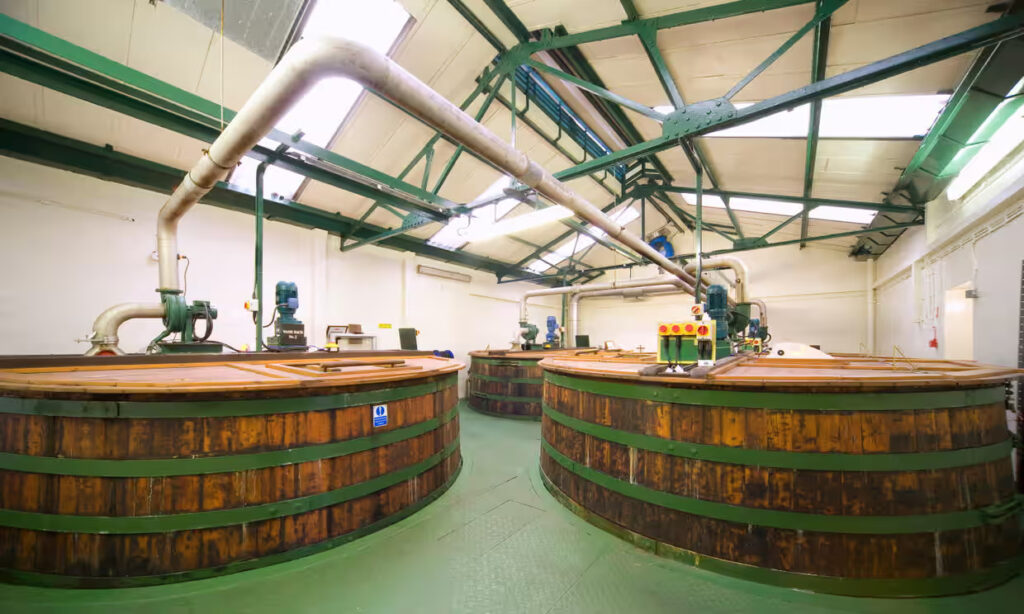Scotland is synonymous with whisky, and for good reason. The country is home to some of the world’s most famous distilleries, each with its own unique story and flavor profile. In this article, we will take you on a journey through the whisky-making process, exploring the renowned distilleries that dot the Scottish landscape.
From the peat-rich soils of Islay to the rolling hills of Speyside, Scotland’s distilleries offer a glimpse into the rich heritage and craftsmanship that goes into creating a fine dram of whisky. Discover the centuries-old traditions that are still upheld today, and learn about the intricate process of malting, mashing, fermenting, distilling, and maturing that transforms barley into liquid gold.
Whether you’re a whisky connoisseur or simply curious about the world of Scotch, this article will provide you with a comprehensive guide to Scotland’s famous distilleries. We’ll delve into the history, techniques, and flavors that make each distillery unique, allowing you to appreciate the subtleties and nuances of Scotland’s national drink.
So grab a glass, pour yourself a dram, and join us on this whisky-filled adventure as we journey through the heart and soul of Scotland’s distillery landscape. Slàinte mhath!
History of Whisky Production in Scotland
Whisky production in Scotland dates back centuries, with the earliest records dating back to the late 15th century. The art of distilling was brought to Scotland by Irish monks, who used their knowledge of distillation to create potent spirits for medicinal purposes. Over time, the production of whisky evolved from a small-scale operation to a thriving industry.
The development of whisky in Scotland was greatly influenced by government regulations and taxes. In the 18th century, the introduction of the Excise Act led to the rise of illicit distilling, as many distillers sought to avoid paying taxes on their production. This period, known as the “Whisky Wars,” shaped the industry and led to the formation of legal distilleries.
During the 19th century, the whisky industry experienced rapid growth and innovation. The invention of the continuous still by Aeneas Coffey revolutionized the production process, allowing for greater efficiency and consistency in the spirit. This paved the way for the emergence of the blended whisky style, which remains popular to this day.
Regions and Styles of Scotch Whisky
Scotland’s whisky production is divided into five main regions, each with its own distinct style and character. These regions are the Highlands, Speyside, Lowlands, Islay, and the Islands. Each region’s whiskies are influenced by factors such as the local water source, climate, and traditional production methods.
The Highlands region is the largest and most diverse, with a wide range of distilleries producing whiskies that vary in flavor and style. From the rich, full-bodied drams of Dalmore to the light and floral whiskies of Glenmorangie, the Highland whiskies offer something for every palate.
Speyside, located within the Highlands, is known as the heartland of Scotch whisky production. It is home to over half of Scotland’s distilleries, including iconic names such as Macallan, Glenfiddich, and Balvenie. Speyside whiskies are often characterized by their fruity, honeyed notes and smooth, approachable flavors.
The Lowlands region is known for producing lighter, more delicate whiskies. Traditionally triple distilled, these whiskies are often described as being light-bodied with floral and grassy notes. Distilleries such as Auchentoshan and Glenkinchie showcase the elegance and subtlety of Lowland whiskies.
Islay, located on the western coast of Scotland, is famous for its peaty and smoky whiskies. The island’s unique terroir, characterized by peat-rich soils and maritime influence, imparts distinct flavors and aromas to the whiskies produced here. Laphroaig, Ardbeg, and Lagavulin are just a few of the renowned distilleries that call Islay home.
The Islands of Scotland, including Orkney, Skye, and Arran, produce whiskies that showcase a wide range of styles and flavors. From the maritime influence of Talisker on the Isle of Skye to the fruity and robust whiskies of Highland Park on Orkney, each island has its own unique contribution to the world of Scotch whisky.
Famous Distilleries in the Highlands Region
The Highlands region is home to some of Scotland’s most famous and iconic distilleries. One such distillery is The Macallan, known for its rich and complex single malt whiskies. The Macallan is renowned for its use of sherry casks in the maturation process, which imparts a distinctive flavor profile characterized by dried fruits, spices, and oak.
Another notable distillery in the Highlands is Glenmorangie. Known for its tall copper stills, Glenmorangie produces whiskies that are often described as elegant and floral. The distillery’s flagship expression, Glenmorangie Original, is a crowd-pleasing whisky with notes of citrus, vanilla, and almond.
Dalmore, located on the picturesque shores of the Cromarty Firth, is famous for its luxurious and indulgent whiskies. The distillery’s whiskies are often finished in a variety of cask types, including sherry, port, and bourbon, resulting in complex and multi-layered flavor profiles.
Iconic Distilleries in the Speyside Region
Speyside is home to some of the most well-known and revered distilleries in Scotland. One such distillery is The Glenlivet, often referred to as the “single malt that started it all.” The Glenlivet is known for its smooth and approachable whiskies, with flavors of orchard fruits, vanilla, and honey.
Glenfiddich, founded in 1887, is another iconic distillery in the Speyside region. It is one of the few remaining family-owned distilleries in Scotland and is known for its pioneering spirit and commitment to quality. Glenfiddich whiskies are characterized by their fruity and floral notes, with a touch of oak and spice.
Balvenie, located next to Glenfiddich, is unique in that it still grows and malts its own barley on-site. This “field-to-bottle” approach allows Balvenie to have complete control over the production process, resulting in whiskies that are rich, complex, and full of character.
Distilleries to Visit in the Lowlands Region
The Lowlands region may be small in terms of the number of distilleries, but it is big on charm and history. Auchentoshan, located just outside of Glasgow, is one of the few remaining distilleries in the region. Known for its triple distillation process, Auchentoshan whiskies are light and delicate, with flavors of citrus, vanilla, and grass.
Glenkinchie, situated near Edinburgh, is another notable distillery in the Lowlands. Its whiskies are often described as being light-bodied with floral and fruity notes. Glenkinchie 12 Year Old, for example, is a classic expression with flavors of apple, citrus, and vanilla.
The Lowlands region may not have as many distilleries as other regions, but it makes up for it with the quality and elegance of its whiskies. A visit to the Lowlands offers a different perspective on Scotch whisky production and allows you to appreciate the subtleties of this unique style.
Exploring the Islay Region’s Peaty Whiskies
For those who enjoy peaty and smoky whiskies, the Islay region is a must-visit destination. Islay whiskies are known for their distinctive flavors, which are a result of the island’s peat-rich soils and maritime climate. These whiskies often have strong, smoky aromas and flavors, with notes of brine, iodine, and earthiness.
Laphroaig, one of the most well-known distilleries on Islay, produces whiskies that are loved by peat enthusiasts around the world. Laphroaig whiskies are characterized by their powerful and medicinal flavors, with hints of seaweed, smoke, and peat. The distillery’s flagship expression, Laphroaig 10 Year Old, is a true Islay classic.
Ardbeg, located on the southern coast of Islay, is another iconic distillery that is revered for its peaty whiskies. Ardbeg whiskies are known for their intense and complex flavors, with notes of smoke, tar, and citrus. The distillery’s flagship expression, Ardbeg 10 Year Old, is a bold and robust whisky that showcases the best of Islay’s peaty character.
Lagavulin, situated on the picturesque shores of Lagavulin Bay, is known for producing whiskies with a perfect balance of smoke, sweetness, and maritime influence. Lagavulin whiskies are often described as being rich, smoky, and full-bodied, with flavors of peat, oak, and dark chocolate.
Unique Distilleries on the Islands of Scotland
The Islands of Scotland, including Orkney, Skye, and Arran, are home to a number of distilleries that produce whiskies with their own distinct character and style. One such distillery is Talisker, located on the Isle of Skye. Talisker whiskies are known for their maritime influence, with flavors of sea salt, smoke, and pepper. The distillery’s flagship expression, Talisker 10 Year Old, is a robust and smoky whisky that captures the essence of the island.
Highland Park, situated on the Orkney Islands, is another unique distillery that produces whiskies with a rich and complex character. Highland Park whiskies are known for their balance of sweet and smoky flavors, with notes of honey, heather, and peat. The distillery’s 12 Year Old expression is a great introduction to the Highland Park range.
Arran, located off the west coast of Scotland, is known for its fruity and approachable whiskies. The distillery’s whiskies are often characterized by their citrusy and tropical fruit flavors, with a touch of spice and oak. Arran 10 Year Old, for example, is a smooth and well-balanced whisky that showcases the best of the island’s character.
Whisky Tasting Tips and Etiquette
Tasting whisky is an art in itself, and there are a few tips and etiquette to keep in mind when enjoying a dram. Firstly, it’s important to use a tulip-shaped glass, as this helps concentrate the aromas and enhances the overall tasting experience. Secondly, take your time to observe the whisky’s color, clarity, and viscosity, as these can provide insights into its age and cask influence.
When nosing the whisky, gently swirl the glass to release the aromas, and take short sniffs to fully appreciate the complexity of the whisky. Note any dominant scents and try to identify different aromas, such as fruits, spices, or smokiness. When tasting, take a small sip and let the whisky coat your palate before swallowing. Pay attention to the flavors and textures, and consider how they evolve from the initial sip to the finish.
When it comes to adding water or ice to your whisky, it ultimately comes down to personal preference. Some whiskies may benefit from a few drops of water, as it can open up the flavors and reduce any harshness. However, if you prefer to drink your whisky neat, that’s perfectly acceptable too. The key is to enjoy the whisky in a way that brings out the flavors and aromas that you personally enjoy.
Conclusion: The Rich Heritage of Scotch Whisky
Scotland’s famous distilleries are a testament to the rich heritage and craftsmanship that goes into creating a fine dram of whisky. From the traditional production methods passed down through generations to the unique flavors and aromas that each distillery produces, Scotch whisky is a true reflection of Scotland’s terroir and culture.
Whether you prefer the smoky and peaty whiskies of Islay or the elegant and fruity expressions of Speyside, there is a whisky for every taste and occasion. So next time you pour yourself a dram, take a moment to appreciate the history, techniques, and flavors that make each distillery unique. Slàinte mhath!


